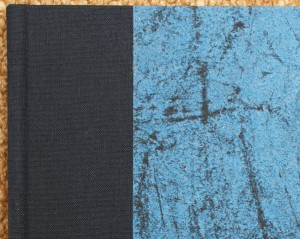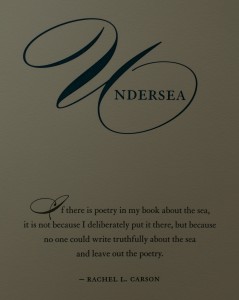 Rachel Carson is one of my heroes. Her book Silent Spring shook up the global environmental movement, created enough of a stir to get DDT banned in the U.S., and created the momentum to create the Environmental Protection Agency. For her contributions she was awarded the Presidential Medal of Freedom by Carter. One of my early childhood memories comes from around the late 1960’s when I lived in Key West Florida. My friends and I thought it was fun to ride behind the mosquito-sprayer trunk, disappearing in and out of the “fog”. It still makes me nervous to think that was probably a cloud of DDT I was breathing.
Rachel Carson is one of my heroes. Her book Silent Spring shook up the global environmental movement, created enough of a stir to get DDT banned in the U.S., and created the momentum to create the Environmental Protection Agency. For her contributions she was awarded the Presidential Medal of Freedom by Carter. One of my early childhood memories comes from around the late 1960’s when I lived in Key West Florida. My friends and I thought it was fun to ride behind the mosquito-sprayer trunk, disappearing in and out of the “fog”. It still makes me nervous to think that was probably a cloud of DDT I was breathing.
 Indirectly, she also was involved in my love for fine press books, as I subscribed to Easton Press’ Books that Changed the World series mainly to get their edition of her book. That was fine press to me 20 years ago. My tastes have evolved along with my knowledge of publishing, bookmaking, and the workings of fine presses. Easton Press books now take a backseat to books from presses like the Nawakum Press. I was so excited to discover that the Press had given Carson’s essay Undersea the fine press treatment.
Indirectly, she also was involved in my love for fine press books, as I subscribed to Easton Press’ Books that Changed the World series mainly to get their edition of her book. That was fine press to me 20 years ago. My tastes have evolved along with my knowledge of publishing, bookmaking, and the workings of fine presses. Easton Press books now take a backseat to books from presses like the Nawakum Press. I was so excited to discover that the Press had given Carson’s essay Undersea the fine press treatment.
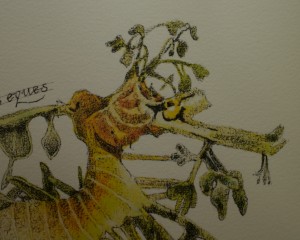 One of the reasons this blog even exists is that I felt there was a paucity of resources to learn about some of the fabulous books put out by small presses. If you’re lucky enough to attend an event like CODEX or the Oxford Fine Press Fair, you might get to hold one of these beauties in your hand and see if it speaks to you. But short of that, most of the press websites don’t give me enough information on the books, especially photographically. Sellers of used books are usually even worse, providing just enough images to convince you that the book is in the stated conditions rather than giving you a feel for the book you are buying. In this respect, Nawakum’s website is one of the best of the small press websites. The prospectus is on-line and there are plenty of pictures of their books to view. In the case of Undersea, there are 13 pictures showing both states of the book. This is really helpful to prospective buyers and subscribers. It also makes my review easier as I don’t feel the need to take as many pictures of the book for this blog. Make sure you check out all the images at the Press’ website here.
One of the reasons this blog even exists is that I felt there was a paucity of resources to learn about some of the fabulous books put out by small presses. If you’re lucky enough to attend an event like CODEX or the Oxford Fine Press Fair, you might get to hold one of these beauties in your hand and see if it speaks to you. But short of that, most of the press websites don’t give me enough information on the books, especially photographically. Sellers of used books are usually even worse, providing just enough images to convince you that the book is in the stated conditions rather than giving you a feel for the book you are buying. In this respect, Nawakum’s website is one of the best of the small press websites. The prospectus is on-line and there are plenty of pictures of their books to view. In the case of Undersea, there are 13 pictures showing both states of the book. This is really helpful to prospective buyers and subscribers. It also makes my review easier as I don’t feel the need to take as many pictures of the book for this blog. Make sure you check out all the images at the Press’ website here.
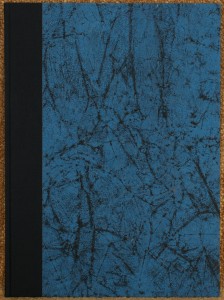 My copy of Undersea is from the slipcased state. It is a beautiful book that is a joy to read. The handmade paper cover is delightful and in a blue and black that seems entirely appropriate to the subject matter, evoking the colors of the sea. I love the use of the Burges Script typeface for capitals at the beginnings of each section and the fact that the capital and first part of the line is continued in blue ink, creating a lovely contrast with the black ink used for the main text. The bite and crispness of the letterpress printing is perfect. Dugald Stermer’s illustrations are reproduced in stunning color. I especially love the way the illustrations work with the overall page design for the Title Page and for the first page of Carson’s essay. (Again, check their website for a great picture of both of these). Finally, the printing of the main essay in a larger type than the Introduction and Afterword was a nice touch that emphasizes Carson’s writing. It is easy to see that much thought and work went into the design of this book between David Pascoe and the others that help create this wonderful book.
My copy of Undersea is from the slipcased state. It is a beautiful book that is a joy to read. The handmade paper cover is delightful and in a blue and black that seems entirely appropriate to the subject matter, evoking the colors of the sea. I love the use of the Burges Script typeface for capitals at the beginnings of each section and the fact that the capital and first part of the line is continued in blue ink, creating a lovely contrast with the black ink used for the main text. The bite and crispness of the letterpress printing is perfect. Dugald Stermer’s illustrations are reproduced in stunning color. I especially love the way the illustrations work with the overall page design for the Title Page and for the first page of Carson’s essay. (Again, check their website for a great picture of both of these). Finally, the printing of the main essay in a larger type than the Introduction and Afterword was a nice touch that emphasizes Carson’s writing. It is easy to see that much thought and work went into the design of this book between David Pascoe and the others that help create this wonderful book.
The book begins with an informative introduction by Linda Lear. I learned that Carson’s early writings were on the natural history of my beloved Chesapeake Bay for The Baltimore Sun. I might have to search those writings out someday, if they still exist in an archive somewhere. I didn’t know or had forgotten her ties to my Maryland heartland. Lear highlights Carson’s “ability to reach millions of people with her eloquence and her calm, reflective passion for the relationship of all life to life [that] has left an indelible imprint on the world’s environmental consciousness.” In the afterword, Julia Whitty notes that Carson passed on too early to reap the benefit and take joy in the discoveries that have been made over the 40 years since her death. She also writes that Carson would be just as concerned about the state of the oceans today as she was by the degradation of our land by the massive use of pesticides in the ‘60s.
 Despite the lack of our newfound knowledge of the sea, Carson’s eloquence in describing the sea is profound. “Who has known the ocean?”, she asks. “To sense this world of waters known to creatures of the sea we must shed our human perceptions of length and breadth and time and place, and enter vicariously into a universe of all-pervading water.” She takes us on a journey from the tidal pools and the surface of the oceans, down through the well-lit shallows, to the deepest and darkest abysmal depths.
Despite the lack of our newfound knowledge of the sea, Carson’s eloquence in describing the sea is profound. “Who has known the ocean?”, she asks. “To sense this world of waters known to creatures of the sea we must shed our human perceptions of length and breadth and time and place, and enter vicariously into a universe of all-pervading water.” She takes us on a journey from the tidal pools and the surface of the oceans, down through the well-lit shallows, to the deepest and darkest abysmal depths.
What makes this essay and Rachel Carson’s writing so beautiful? I think she sums it up in the statement at the beginning of the book:
“If there is poetry in my book about the sea, it is not because I deliberately put it there, but because no one could write truthfully about the sea and leave out the poetry.”
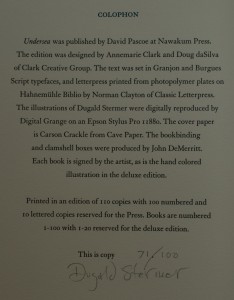 AVAILABILITY: The Deluxe edition of 20 copies is out of print. The Slipcased edition of 80 copies is available through the Nawakum Press website.
AVAILABILITY: The Deluxe edition of 20 copies is out of print. The Slipcased edition of 80 copies is available through the Nawakum Press website.
NOTE: The Whole Book Experience would like to thank David Pascoe and the Nawakum Press for the generosity that made this review possible.

